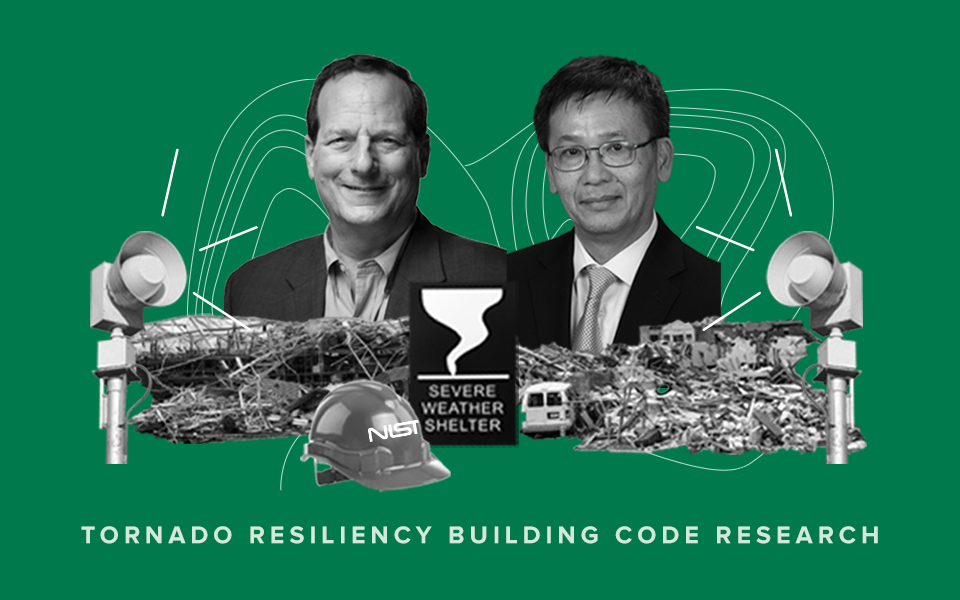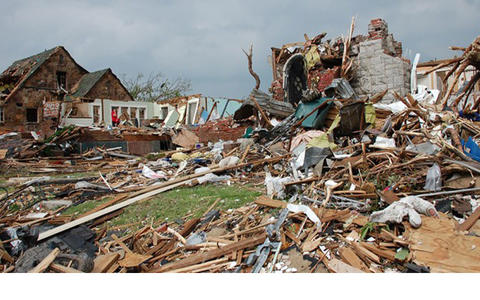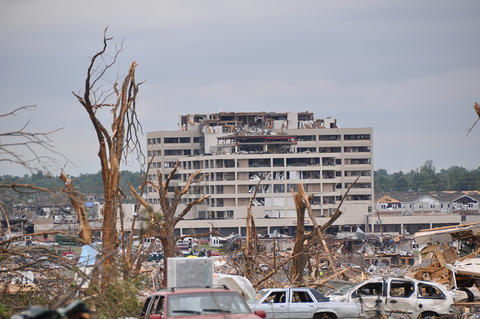Taking Measure
Just a Standard Blog

Tornadoes are dramatic and deadly natural disasters. Over 1,200 tornadoes touch down in the U.S. every year — causing dozens of deaths. Until recently, a common perception among structural engineers was that tornadoes were too intense to design buildings to withstand them.
But thanks to decades of research at NIST, that misconception has changed.
For the first time, the 2024 version of the International Building Code (IBC) contains a section on tornado resiliency. The IBC is a reference document that’s widely used to create local building code laws. These new building codes will save lives.
In recognition of their work on tornadoes, Long Phan and Marc Levitan have been named finalists for the Samuel J. Heyman Service to America Medal, also known as the Sammie. The Sammies recognize federal employees for outstanding public service.
As Sammies finalists, Long Phan and Marc Levitan are also eligible for the Sammies’ People’s Choice Awards. Vote every day to support their nomination on the Partnership for Public Service’s website.
Phan is the leader of the Structures Group at NIST, where he has worked for nearly 40 years studying how buildings and structures respond to extreme hazards.
Levitan is a wind and structural engineer. He is the lead research engineer for the National Windstorm Impact Reduction Program.
Both have played a critical role in changing minds about designing for tornadoes by conducting groundbreaking research and advocating for changes to building codes and standards.
The Taking Measure blog sat down with Phan and Levitan to ask them about their careers and the remarkable journey to make our communities more resilient to tornadoes.
What does a wind engineer do?

Marc Levitan: We study wind effects on buildings and infrastructure. Basically, it’s how wind interacts with the building and how that creates stress on the structure, known as loads. We study how the building resists those loads.
Long Phan: I tend to focus on research areas that potentially have a practical impact. For example, with tornadoes, we kept seeing the same type of damage occurring tornado after tornado. We started saying, “Let's develop standards to allow the engineering community to design for tornadoes for the first time.” That was a very lofty goal.
What about tornado research pulls you in?
Marc Levitan: I was fascinated with windstorms even when I was a child. We lived in Pennsylvania. Hurricane Agnes hit, and I remember there was a tiny little creek in our neighborhood. I watched that turn into a raging river that swallowed up and damaged the houses across the street. Then the water rose in our basement. I saw all my toys floating around. My mom was all scared and worried about it, but I was like, “This is pretty interesting!”
As I went through school, I also became interested in construction, and those two things sort of came together.
In particular, I saw the chance to study something that wasn’t as well studied as it needed to be and the chance to have a significant impact on engineering practice.
Why study natural disasters?

Long Phan: Nature is a kind of a super laboratory, right? There is no better way to learn from your structural design than by looking at how it performs under extreme conditions.
Natural disasters bring a lot of devastation and loss of life. But they also provide us with unique opportunities to test our knowledge of how we design structures.
So, when there’s a natural disaster, we like to learn from it. What worked? Why did one building stand up and the next building fall down?
Also, natural disaster research is more persuasive to the engineering community. People cannot argue with evidence from a real building.
Do tornadoes only happen in the United States?
Marc Levitan: No. Tornadoes occur in many places around the world. But because of our unique geography in the United States, tornadoes are more frequent and more intense here than in any other place.
What makes them so dangerous?
Marc Levitan: A combination of factors. The average warning time is only about 13 minutes. And sometimes it’s much less than that. And until very recently, we didn’t have any requirements for tornado loads in the building code.
With a combination of poor construction and an intense tornado, you can have complete destruction of a house. Even the debris is gone, and there’s nothing left but the slab. There are cases in which a whole house can slide off its foundation or tumble away.
Most tornadoes are not that intense. Wind speeds of 130 mph or less will do a lot of damage to a house but typically wouldn’t lead to complete destruction of the building.
Why do tornadoes tend to lift roofs off of buildings?
Marc Levitan: As the air accelerates to go over the roof of the building, you get some uplift pressure. It’s similar to wind flow over an airplane wing. This wind-induced uplift occurs in all types of windstorms.
Tornadoes, though, have two additional phenomena affecting loads on the roof. Strong updrafts near the core of the tornado accentuate the wind-induced uplift. The other component is atmospheric pressure change. In the core of a tornado, there is lower atmospheric pressure. When that tornado moves across a building that is relatively well sealed, higher atmospheric pressure inside the building can push up on the roof and push out on the walls.
How could you change a building’s design to keep that from happening?
Marc Levitan: The key thing to prevent the roof from coming off is you need to have a strong load path. So that means you have to connect all the pieces from each individual shingle on the roof, all the way down to the foundation.
That sounds pretty expensive. How much does it cost to make these upgrades?
Marc Levitan: No, it’s not very expensive at all. It may cost maybe $500 or $1,500 extra on new construction to tie all that together for a typical-size home.
How are building codes created?
When buildings fail to keep their occupants safe or even come close to failing during a catastrophic event — natural, human-caused or a mix of both — organizations step up to study what caused the failure. Then, government and industry organizations take action through established processes to etch those lessons into building codes. Learn more about how building codes are created and NIST’s role in keeping you safe in buildings.
What was the moment that you realized that the building codes for tornadoes needed to be updated?
Long Phan: Not updated. There was nothing there before. We had to develop a brand-new provision chapter in the building code.
In 1997, a big tornado hit Jarrell, Texas.
At the time, the National Weather Service rated tornadoes using the Fujita scale. The Fujita scale estimates tornado wind speed by assessing the damage it caused. It assumes that more damage means there was a higher wind speed. The Jarrell tornado was rated as an F5, the highest possible Fujita rating.
As a structural engineer with experience in structural failure, when I looked at the Jarrell tornado, I just didn’t think that the damage was necessarily caused by extremely high wind speed. So, I began to think, “OK, the Fujita scale might not be accurate.”
So, the original scale said that tornadoes were much faster than they were in reality?
Long Phan: Yes. Because of the old Fujita scale, engineers thought the typical tornado was extremely powerful. That made the engineering community throw up their hands and say, “Hey, these tornado wind speeds are so high, there’s no way we can economically design structures to withstand them. A building would have to be a stone pyramid or something to be able to resist it.” People gave up right away on designing for tornadoes.
So, our finding that the Fujita scale wasn’t accurate was great news. That was the first step in starting a paradigm shift. It’s not hopeless. Yes, we can design for tornado resiliency.
So I wrote an article a year after the Jarrell, Texas, tornado, together with Emil Simiu. For the first time, we showed that the wind speed that caused the damage was much slower than what the Fujita scale said. We said, “We need to improve the Fujita scale.”
NIST then funded Texas Tech University to try to calculate the wind speed more accurately. Eventually that led to the Enhanced Fujita scale, which is more accurate. It’s a major improvement in tornado rating. The Weather Service adopted the scale in 2007.
The Enhanced Fujita scale is more accurate than the original Fujita scale because it takes new details into account. One of these new details is construction quality. If part of a building is poorly constructed, it will be destroyed by a less severe tornado. It seems like a simple idea, but in extreme cases like the Jarrell tornado, this insight could mean the difference between a rating of 3 and 5.
Marc Levitan: The Enhanced Fujita scale rates tornadoes from EF0 through EF5.
EF0 is the lowest intensity. And that’s going to be modest damage, like damage to tree branches, gutters coming off of a building, things like that.
The other end of the scale is EF5. That’ll have the highest wind speeds. At that point, all except for the most well-built homes will be destroyed, and maybe there won’t even be any debris, just a slab left.
Long Phan: Ninety-seven percent of the tornadoes in the country are of lower wind speed, EF2 or lower. And those are wind speeds that we can easily design for.
We started questioning the common perception that we can’t prepare buildings for tornadoes. Are tornadoes really so strong to the point where we throw up our hands and never design for them?
These ideas marinated over many years until the 2011 Joplin, Missouri, tornado.
Tell me about the Joplin tornado.

Marc Levitan: The Joplin tornado was an EF5 tornado. The Weather Service estimated speeds of 200-plus mph. It struck right through the heart of the city of Joplin, a town of about 50,000 people. It damaged or destroyed about a third of that city, nearly 8,000 buildings. There were 161 fatalities due to the storm and a cost of $3 billion. That made it the single deadliest and the single costliest tornado since we began keeping official records in 1950.
Two days after the tornado hit, NIST had a team on the ground in Missouri trying to understand the damage and understand what the failure mechanisms were.
Would you say that the new building code stems from the Joplin research?
Marc Levitan: Yes. At the conclusion of our study, we published a technical report in 2014. And as part of that report, we had a series of recommendations for next steps, including working toward new building codes and standards. We immediately started a long-term follow-up project to implement those recommendations.
A decade of tornado research led by NIST resulted in a new set of tornado hazard maps for the U.S. and a chapter on tornado load requirements in the American Society of Civil Engineers (ASCE) Standard for Minimum Design Loads on Buildings and Other Structures, called ASCE 7.
Then, we worked with ASCE and the Federal Emergency Management Agency to propose changes to the International Building Code (IBC) to incorporate those requirements into the 2024 IBC.
What’s different about the new model building code?

Marc Levitan: For the first time, the building code includes requirements for the design of many conventional buildings to resist tornadoes. Those requirements apply to certain types of important structures in the community, what the building code identifies as Risk Categories 3 and 4.
Risk Category 3 would be things like schools, nursing homes and high occupancy buildings, such as theaters. Risk Category 4 includes essential facilities: fire and police stations, hospitals, EMS facilities, etc.
How does it feel to have all this work finally come out into the International Building Code?
Long Phan: It’s immensely satisfying. It was beyond our wildest imagination. When we developed the Joplin Recommendation Implementation Project in 2014, we outlined the plan to get here.
But we don’t have total control of the process. The wind-engineering community could easily say, “No. We have not designed for tornadoes before. We don’t want to design for tornadoes now.” We had to convince people about the need for tornado resiliency.
We hoped that we could start a paradigm shift in building standards, but realistically, in 2014, we didn’t know we could get here. And so, it’s just amazing.
What’s next for you and your research?
Marc Levitan: We still have a lot of work to do on tornadoes. We have only just now gotten a first version of tornado loads in the standard and code. We still have a lot more to learn about tornadoes to fill in knowledge gaps and improve our tornado load requirements in future editions of the standard and code.
Not only do we have to develop these standards, but we also have to work to help get them adopted. And so that means providing support for state and local communities to be able to better understand and adopt those tornado requirements that are in the model building codes.
Long Phan: I’m leading a project on how climate will affect future codes and standards. We need to work with climatologists and meteorologists to project the changing hazards in the future.
Buildings typically last for 50 or 100 years. By then, the environmental hazards might be different because of climate change. Tornadoes might be more intense, for example. There are also subtle changes. For example, higher temperatures might affect the performance of construction materials and alter buildings’ expected performance in future conditions.
So, we are trying to project the effects of climate on these hazards and plan for it so that buildings will remain resilient in the future.
About the author
Related Posts
Comments
Thank you for this article!
About 15 years ago, About 15 years ago, I was at a training class on structural design given by a very well known and respected structural engineer who published a lot of articles in trade magazines. I asked the question why the wind speeds in places like Oklahoma, where I grew up, were so low, when often there are storms with high winds, and known as "tornado alley". He berated my question in front of a bunch of engineers as being silly, and said simply we couldn't design buildings for tornadoes, and then moved on. Similarly, the contractor building my mother's house in Oklahoma at the time also thought that anchor bolts was a waste of money, reflecting the same fatalistic attitude.
I feel vindicated. Thank you for your work.






I'm interested